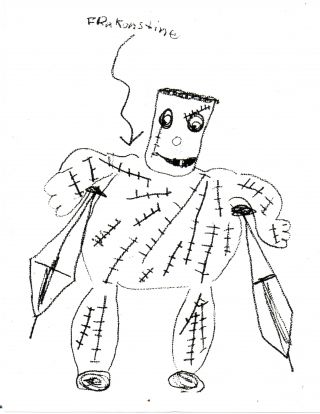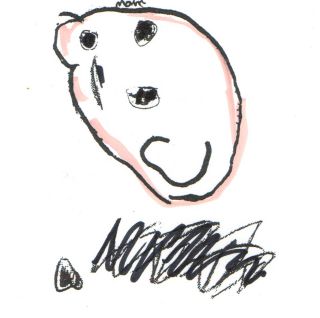Trauma
Art Therapy, Children and Interpersonal Violence
Art therapy helps children release their inner monsters.
Posted October 13, 2013

"Frankenstein Got Beat Up," © 2013 Courtesy of Cathy Malchiodi, PhD
Child abuse is widely recognized as a serious problem that is part of the spectrum of interpersonal violence and includes physical, sexual, emotional and verbal abuse and neglect. It is essentially any act of commission or omission that endangers or harms a child’s physical or emotional health and development. Violence and assault to children may result in numerous adverse outcomes including insecure or disrupted attachment, mood, and behavioral challenges, and acute or posttraumatic stress reactions, among other problems.
Art therapy, an approach used in the treatment of trauma reactions, is often a primary form of therapy with children who are recovering from abuse, and neglect or are witnesses to family violence. For several decades, art therapy has been documented as an important method in addressing the emotional pain of young survivors of interpersonal violence. In general, practitioners contend that therapeutic art expression and play are ways that children mediate and resolve traumatic experiences. We also now know that the experience of interpersonal violence can result in posttraumatic stress reactions that often interfere with language areas of the brain. In particular, posttraumatic stress reactions cause problems in Broca’s area that governs verbalization; in some cases, Broca’s area is actually shut down if trauma memories are overwhelming or recurrent. Art expression allows communication of trauma memories through the sensory aspects of drawing, painting and other media, thus often bypassing the impact of posttraumatic reactions' impact on Broca's area. Emerging research indicates that art expression may even help stimulate verbalization of emotionally laden events, including traumatic ones.
More than two decades ago I first wrote about art therapy’s emerging efficacy as a treatment for children impacted by family violence from a personal perspective: “Like many art therapists, I have often utilized art to make sense of trauma in my own life. Art expression has been the key to understanding loss, crisis and emotional upheaval when words could not adequately express or contain meaning. The value of art expression is not only the images themselves, but also immersion in the creative process…As Rollo May notes, ‘In all creativity, we destroy and rebuild the world, and at the same time we inevitably rebuild and reform ourselves.’”

"Monster Mask," © 2013 Courtesy of Cathy Malchiodi, PhD
In the past decade, neurobiology and current research on trauma have redefined our understanding of children’s experiences with interpersonal violence; recent findings on art and the brain increasingly explain why art therapy is a game-changer in trauma intervention, particularly with children who have been abused. Despite all these exciting developments, I continue to be captivated by what these children, including the youngest survivors, are able to communicate through visual images. When I first started to work with children who had experienced interpersonal violence, I was initially struck by the theme of monsters in their art expressions. Monsters are not an unusual theme in children’s art, but for children who have experienced interpersonal violence, these monsters often take on both idiosyncratic and universal meanings. Many children may literally depict a real-life monster that represents an abusive parent, neglectful caretaker, a bully or anyone whose intent is to terrorize or intimidate. These images often reveal a foreboding entity capable of hurt and harm to those less powerful. Other children depict themselves as monsters that have superpowers over others, aligning themselves with the aggressive nature of their own perpetrators.
At other junctures in treatment, the monsters depicted in art and play are less literal, but are just as real. They are what I call the “inner monsters” that communicate the sensory, emotional and psychosocial experiences of abuse and neglect. Because a monster is sometimes perceived as hideous or repulsive, children may also convey their own self-perceptions of being flawed or unwanted in their monster images. These depictions often reflect guilt and shame-laden beliefs that these young survivors caused their physical abuse, sexual assault or psychological torture. In all cases, these images reveal profound sadness, loneliness, anxiety and fear common to individuals whose lives have been threatened or controlled.

"Mom, My Monster," © 2013 Courtesy of Cathy Malchiodi, PhD
October is Domestic Violence Awareness Month, a time to reflect on efforts to address interpersonal violence and remember that many survivors still need services to support reparation and recovery. In particular, child survivors of interpersonal violence are silent in their suffering and often afraid of divulging the secret of their abuse, making them the most vulnerable. Art expression is one way to communicate what is unspoken and unspeakable; art therapy is a developmentally appropriate approach to assisting children in their emotional reparation and in the recovery of what has been stolen from them by abuse and neglect. By providing these children with the chance to express their inner worlds through art, we inevitably offer them the opportunity to release the inner monsters that torment them and ultimately rob them of trust, safety, happiness and a sense of wholeness.
**This is the first of a multi-part series on creative arts therapy and interpersonal violence. Upcoming posts address the key neurobiological reasons why art expression ameliorates violence, particularly in children and adults who have experienced interpersonal trauma, how creative art therapies trump bullying, and what we can and cannot deduce from abused children’s art expressions.
Be well,
Cathy Malchiodi, PhD, LPCC, LPAT, ATR-BC
© 2013 Cathy Malchiodi
Art Therapy Without Borders on Facebook—over 20,000 followers and growing! https://www.facebook.com/arttherapywithoutborders
For information on Trauma-Informed Art Therapy®--- visit Trauma-Informed Practices and Expressive Arts Therapy Institute at www.trauma-informedpractice.com
References/Resources
Malchiodi, C. A. (1990, 1997). Breaking the silence: Art therapy with children from violent homes. New York: Routledge [look for the new edition in 2014].
Malchiodi, C. A. (2012). Art therapy and the brain. In C. Malchiodi (Ed.), Handbook of Art Therapy. New York: Guilford Press.
Malchiodi, C. A. (2008). Creative interventions with traumatized children. New York: Guilford Press.
Waller, D. (2006). Art therapy for children: How it leads to change. Clinical Child Psychology and Psychiatry, 11, 271-282.
Gilroy, A. (2006). Art therapy, research and evidence-based practice. London: SAGE Publications.




